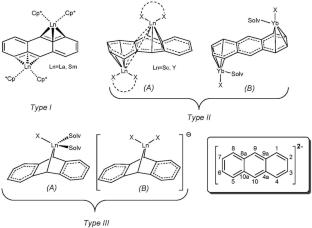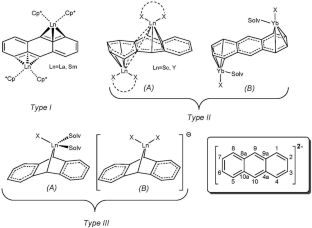含蒽和多苯基取代环戊二烯配体的单核钇和镥配合物的结构研究
IF 2.2
4区 化学
Q3 CHEMISTRY, MULTIDISCIPLINARY
引用次数: 0
摘要
单核环戊二烯基蒽络合物[(1,3-Ph2C5H3)Lu(C14H10)(THF)2]-THF(1a)、[(1,2,4-Ph3C5H2)Lu(C14H10)(THF)2]-0.17己烷-1.53THF (2a)、[(1,2,4-Ph3C5H2)Lu(C14H10)(THF)2]-3C6D6 (2b)、[(1,2,4-Ph3C5H2)Y(C14H10)(THF)2] -0.23hexane-1.37THF (3a)和[(1,2,4-Ph3C5H2)Lu(2,6-tBu2C14H8)(THF)2]-0.5THF (4a)。络合物显示出 (η5-C5)Ln(η2-C14)(O)2 结晶节点的结构刚性。讨论了电子和立体效应。以乙烯聚合为例,环戊二烯蒽配合物能够在没有助催化剂的情况下激活 C = C 键。本文章由计算机程序翻译,如有差异,请以英文原文为准。


Structural studies of mononuclear yttrium and lutetium complexes bearing anthracenide and polyphenyl-substituted cyclopentadienyl ligands
Crystal structures of mononuclear cyclopentadienyl-anthracenide complexes [(1,3-Ph2C5H3)Lu(C14H10)(THF)2]•THF (1a), [(1,2,4-Ph3C5H2)Lu(C14H10)(THF)2]•0.17hexane•1.53THF (2a), [(1,2,4-Ph3C5H2)Lu(C14H10)(THF)2]•3C6D6 (2b), [(1,2,4-Ph3C5H2)Y(C14H10)(THF)2] •0.23hexane•1.37THF (3a), and [(1,2,4-Ph3C5H2)Lu(2,6-tBu2C14H8)(THF)2]•0.5THF (4a) have been studied. Complexes exhibit a structural rigidity of the (η5-C5)Ln(η2-C14)(O)2 crystallographic node. Electronic and steric effects are discussed. The cyclopentadienyl-anthracenide complexes are able to activate C = C bonds without a co-catalyst, using ethylene polymerization as an example.
求助全文
通过发布文献求助,成功后即可免费获取论文全文。
去求助
来源期刊

Structural Chemistry
化学-化学综合
CiteScore
3.80
自引率
11.80%
发文量
227
审稿时长
3.7 months
期刊介绍:
Structural Chemistry is an international forum for the publication of peer-reviewed original research papers that cover the condensed and gaseous states of matter and involve numerous techniques for the determination of structure and energetics, their results, and the conclusions derived from these studies. The journal overcomes the unnatural separation in the current literature among the areas of structure determination, energetics, and applications, as well as builds a bridge to other chemical disciplines. Ist comprehensive coverage encompasses broad discussion of results, observation of relationships among various properties, and the description and application of structure and energy information in all domains of chemistry.
We welcome the broadest range of accounts of research in structural chemistry involving the discussion of methodologies and structures,experimental, theoretical, and computational, and their combinations. We encourage discussions of structural information collected for their chemicaland biological significance.
 求助内容:
求助内容: 应助结果提醒方式:
应助结果提醒方式:


